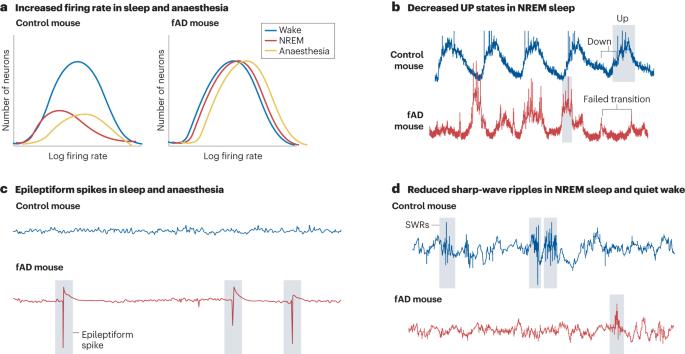Linking activity dyshomeostasis and sleep disturbances in Alzheimer disease
IF 28.7
1区 医学
Q1 NEUROSCIENCES
引用次数: 0
Abstract
The presymptomatic phase of Alzheimer disease (AD) starts with the deposition of amyloid-β in the cortex and begins a decade or more before the emergence of cognitive decline. The trajectory towards dementia and neurodegeneration is shaped by the pathological load and the resilience of neural circuits to the effects of this pathology. In this Perspective, I focus on recent advances that have uncovered the vulnerability of neural circuits at early stages of AD to hyperexcitability, particularly when the brain is in a low-arousal states (such as sleep and anaesthesia). Notably, this hyperexcitability manifests before overt symptoms such as sleep and memory deficits. Using the principles of control theory, I analyse the bidirectional relationship between homeostasis of neuronal activity and sleep and propose that impaired activity homeostasis during sleep leads to hyperexcitability and subsequent sleep disturbances, whereas sleep disturbances mitigate hyperexcitability via negative feedback. Understanding the interplay among activity homeostasis, neuronal excitability and sleep is crucial for elucidating the mechanisms of vulnerability to and resilience against AD pathology and for identifying new therapeutic avenues. Altered network activity during sleep is observed in some individuals with Alzheimer disease and in mouse models of the disorder. In this Perspective, Inna Slutsky proposes that hyperexcitability and sleep disturbances in Alzheimer disease result from disruption of the mechanisms that maintain activity homeostasis in the brain.


将阿尔茨海默病的活动失调与睡眠障碍联系起来
阿尔茨海默病(AD)的无症状阶段始于淀粉样蛋白-β在大脑皮层的沉积,开始于认知能力下降出现之前的十年或更早。痴呆症和神经退行性变的发展轨迹是由病理负荷和神经回路对病理影响的恢复力决定的。在本《视角》中,我将重点介绍最近的研究进展,这些进展揭示了神经回路在老年痴呆症早期阶段容易过度兴奋,尤其是当大脑处于低觉醒状态(如睡眠和麻醉)时。值得注意的是,这种过度兴奋性在出现睡眠和记忆障碍等明显症状之前就已显现。我利用控制论的原理,分析了神经元活动平衡与睡眠之间的双向关系,并提出睡眠期间活动平衡受损会导致过度兴奋和随后的睡眠障碍,而睡眠障碍则会通过负反馈缓解过度兴奋。了解神经元活动平衡、神经元兴奋性和睡眠之间的相互作用,对于阐明AD病理学的脆弱性和恢复力机制以及确定新的治疗途径至关重要。
本文章由计算机程序翻译,如有差异,请以英文原文为准。
求助全文
约1分钟内获得全文
求助全文
来源期刊

Nature Reviews Neuroscience
NEUROSCIENCES-
自引率
0.60%
发文量
104
期刊介绍:
Nature Reviews Neuroscience is a multidisciplinary journal that covers various fields within neuroscience, aiming to offer a comprehensive understanding of the structure and function of the central nervous system. Advances in molecular, developmental, and cognitive neuroscience, facilitated by powerful experimental techniques and theoretical approaches, have made enduring neurobiological questions more accessible. Nature Reviews Neuroscience serves as a reliable and accessible resource, addressing the breadth and depth of modern neuroscience. It acts as an authoritative and engaging reference for scientists interested in all aspects of neuroscience.
 求助内容:
求助内容: 应助结果提醒方式:
应助结果提醒方式:


